Germanic paganism
| Part of a series on |
| Indo-European topics |
|---|
 |
Germanic paganism or Germanic religion refers to the traditional, culturally significant religion of the
Some basic aspects of Germanic belief can be reconstructed, including the existence of one or more origin myths, the existence of a myth of the end of the world, a general belief in the inhabited world being a "
Textual and archaeological sources allow the reconstruction of aspects of Germanic ritual and practice. These include well-attested burial practices, which likely had religious significance, such as rich grave goods and the burial in ships or wagons. Wooden carved figures that may represent gods have been discovered in bogs throughout northern Europe, and rich sacrificial deposits, including objects, animals, and human remains, have been discovered in springs, bogs, and under the foundations of new structures. Evidence for sacred places includes not only natural locations such as sacred groves but also early evidence for the construction of structures such as temples and the worship of standing poles in some places. Other known Germanic religious practices include divination and magic, and there is some evidence for festivals and the existence of priests.
Subject and terminology
Definition
Germanic religion is principally defined as the religious traditions of speakers of Germanic languages (the
Continuity
Because of the amount of time and space covered by the term "Germanic religion", controversy exists as to the degree of continuity of beliefs and practices between the earliest attestations in Tacitus and the later attestations of Norse paganism from the high Middle Ages. Many scholars argue for continuity, seeing evidence of commonalities between the Roman, early medieval, and Norse attestations, while many other scholars are skeptical.[9] The majority of Germanic gods attested by name during the Roman period cannot be related to a later Norse god; many names attested in the Nordic sources are similarly without any known non-Nordic equivalents.[10][11] The much higher number of sources on Scandinavian religion has led to a methodologically problematic tendency to use Scandinavian material to complete and interpret the much more sparsely attested information on continental Germanic religion.[12]
Most scholars accept some form of continuity between Indo-European and Germanic religion,[13] but the degree of continuity is a subject of controversy.[14] Jens Peter Schjødt writes that while many scholars view comparisons of Germanic religion with other attested Indo-European religions positively, "just as many, or perhaps even more, have been sceptical".[15] While supportive of Indo-European comparison, Schjødt notes that the "dangers" of comparison are taking disparate elements out of context and arguing that myths and mythical structures found around the world must be Indo-European just because they appear in multiple Indo-European cultures.[16] Bernhard Maier argues that similarities with other Indo-European religions do not necessarily result from a common origin, but can also be the result of convergence.[17]
Continuity also concerns the question of whether popular, post-conversion beliefs and practices (
Sources
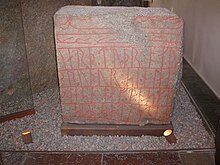
Sources on Germanic religion can be divided between primary sources and secondary sources. Primary sources include texts, structures, place names, personal names, and objects that were created by devotees of the religion; secondary sources are normally texts that were written by outsiders.[27]
Primary sources
Examples of primary sources include some Latin alphabet and Runic inscriptions, as well as poetic texts such as the
Secondary sources
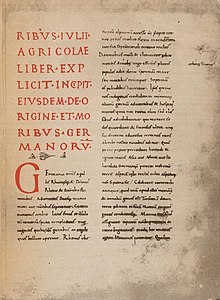
Most textual sources on Germanic religion were written by outsiders.[12] The chief textual source for Germanic religion in the Roman period is Tacitus's Germania.[33][b] There are problems with Tacitus's work, however, as it is unclear how much he really knew about the Germanic peoples he described and because he employed numerous topoi dating back to Herodotus that were used when describing a barbarian people.[35] Tacitus' reliability as a source can be characterized by his rhetorical tendencies, since one of the purposes of Germania was to present his Roman compatriots with an example of the virtues he believed they lacked.[36] Julius Caesar, Procopius, and other ancient authors also offer some information on Germanic religion.[37][c]
Textual sources for post-Roman continental Germanic religion are written by Christian authors: Some of the gods of the
Textual sources for Scandinavian religion are much more extensive. They include the aforementioned poems of the Poetic Edda, Eddic poetry found in other sources, the
Outside influences and syncretism
Germanic religion has been influenced by the beliefs of other cultures. Celtic and Germanic peoples were in close contact in the first millennium BCE, and evidence for Celtic influence on Germanic religion is found in religious vocabulary. This includes, for instance, the name of the deity *Þun(a)raz (Thor), which is identical to Celtic *Toranos (Taranis), the Germanic name of the runes (Celtic *rūna 'secret, magic'), and the Germanic name for the sacred groves, *nemeđaz (Celtic nemeton).[44] Evidence for further close religious contacts is found in the Roman-era Rhineland goddesses known as matronae, which display both Celtic and Germanic names.[45] During the Viking Age, there is evidence for continued Irish mythological and Insular Celtic influence on Norse religion.[46]
During the Roman period, Germanic gods were equated with Roman gods and worshipped with Roman names in contact zones, a process known as Interpretatio Romana; later, Germanic names were also applied to Roman gods (Interpretatio Germanica). This was done to better understand one another's religions as well as to syncretize elements of each religion.[47][48] This resulted in various aspects of Roman worship and iconography being adopted among the Germanic peoples, including those living at some distance from the Roman frontier.[49]
In later centuries, Germanic religion was also influenced by Christianity. There is evidence for the appropriation of Christian symbolism on gold bracteates and possibly in the understanding of the roles of particular gods.
Cosmology
Creation myth
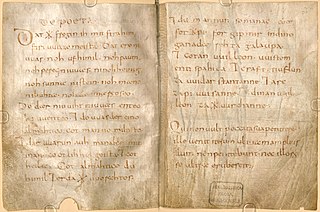
It is likely that multiple creation myths existed among Germanic peoples.
The only Nordic comprehensive origin myth is provided by the
There may be a continuity between Tacitus's account of Tuisto and Mannus and the Gylfaginning account of the creation of the world.
Myth of the end of the world

There is evidence of a myth of the end of the world in Germanic mythology, which can be reconstructed in very general terms from the surviving sources.[69] The best known is the myth of Ragnarök, attested from Old Norse sources, which involves a war between the gods and the beings of chaos, leading to the destruction of almost all gods, giants, and living things in a cataclysm of fire. It is followed by a rebirth of the world.[70] The notion of the world's destruction by fire in the Southern Germanic area seems confirmed by the existence of the word Muspilli (probably "world conflagration") to refer to the end of the world in Old High German; however, it is possible that this aspect derives from Christian influence.[71] Scholarship on Ragnarök tends to either argue that it is a myth with composite, partially non-Scandinavian origins, that it has Indo-European parallels and thus origins, or that it derives from Christian influence.[72]
Physical cosmos
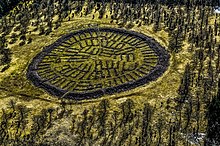
Information on Germanic cosmology is only provided in Nordic sources,[74] but there is evidence for considerable continuity of beliefs despite variation over time and space.[75] Scholarship is marked by disagreement about whether Snorri Sturlason's Edda is a reliable source for pre-Christian Norse cosmology, as Snorri has undoubtedly imposed an ordered, Christian worldview on his material.[76]
Fate
Some Christian authors of the Middle Ages, such as Bede (c. 700) and Thietmar of Merseburg (c. 1000), attribute a strong belief in fate and chance to the followers of Germanic religion. Similarly, Old English, Old High German, and Old Saxon associate a word for fate, wyrd, as referring to an inescapable, impersonal fate or death.[82] While scholarship of the early 20th century believed that this meant that Germanic religion was essentially fatalistic, scholars since 1969 have noted that this concept appears to have been heavily influenced by the Christianized Greco-Roman notion of fortuna fatalis ("fatal fortune") rather than reflecting Germanic belief.[83][84] Nevertheless, Norse myth attests the belief that even the gods were subject to fate.[85][86] While it is thus clear that older scholarship exaggerated the importance of fate in Germanic religion, it still had its own concept of fate. Most Norse texts dealing with fate are heroic, which probably influences their portrayal of fate.[87]
In Norse myth, fate was created by supernatural female beings called
Afterlife
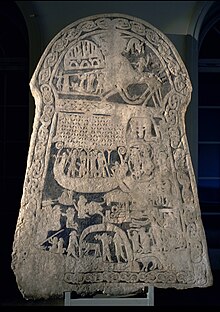
Early Germanic beliefs about the afterlife are not well known; however, the sources indicate a variety of beliefs, including belief in an underworld, continued life in the grave, a world of the dead in the sky, and reincarnation.[92] Beliefs varied by time and place and may have contradictory in the same time and place.[93] The two most important afterlives in the attested corpus were located at Hel and Valhalla, while additional destinations for the dead are also mentioned.[92] A number of sources refer to Hel as the general abode of the dead.[94]
The Old Norse proper noun Hel and its cognates in other Germanic languages are used for the Christian hell, but they originally refer to a Germanic underworld and/or afterlife location that predates Christianization.[95] Its relation to the West Germanic verb helan ("to hide") suggests that it may have originally referred to the grave itself.[96][97] It could also suggest the idea that the realm of the dead is hidden from human view.[98] It was not conceived of as a place of punishment until the high Middle Ages, when it takes on some characteristics of the Christian hell. It is described as cold, dark, and in the north.[99] Valhalla ("hall of the slain"), on the other hand, is a hall in Asgard where the illustrious dead dwell with Odin, feasting and fighting.[100]
Old Norse material often include the notion that the dead lived in their graves, and that they can sometimes come back as
Religiously significant numbers
In Germanic mythology, the numbers three, nine, and twelve play an important role.[104] The symbolic importance of the number three is attested widely among many cultures,[105] and the number twelve is also attested as significant in other cultures, meaning that foreign influence is possible. The number three often occurs as a symbol of completeness, which is probably how the frequent use in Germanic religion of triads of gods or giants should be understood.[104] Groups of three gods are mentioned in a number of sources, including Adam of Bremen, the Nordendorf Fibula, the Old Saxon Baptismal Formula, Gylfaginning, and Þorsteins þáttr uxafóts.[106] The number nine can be understood as three threes.[107] Its importance is attested in both mythology and worship.[108]
Supernatural and divine beings
Gods
The Germanic gods were a category of supernatural beings who interacted with humans, as well as with other supernatural beings such as giants (jötnar), elves, and dwarfs.[109] The distinction between gods and other supernaturally powerful beings might not always be clear.[110] Unlike the Christian god, the Germanic gods were born, can die, and are unable to change the fate of the world.[111] The gods had mostly human features, with human forms, male or female gender, and familial relationships, and lived in a society organized like human society; however, their sight, hearing, and strength were superhuman, and they possessed a superhuman ability to influence the world.[112] Within the religion, they functioned as helpers of humans,[113] granting heil ("good luck, good fortune") for correct religious observance. The adjectival form heilag (English holy) is attested in all Germanic languages, including Gothic on the Ring of Pietroassa.[114]
Based on Old Norse evidence, Germanic paganism probably had a variety of words to refer to gods.
In Norse mythology, the Aesir are one of two families of gods, the other being the
Giants (Jötnar)

Giants (Jötnar) play a significant role in Germanic myth as preserved in Iceland, being just as important as the gods in myths of the cosmology and the creation and the end of the world.
Elves, dwarfs and other beings
Germanic religion also contained various other mythological beings, such as the monstrous wolf
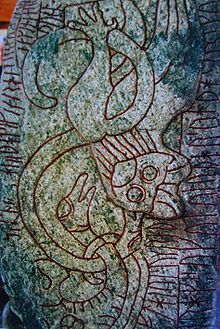
Elves are beings of Germanic lower mythology that are mostly male and appear as a collective.[135] Snorri Sturluson divides the elves into two groups, the dark elves and the light elves; however, this division is not attested elsewhere.[136] People's understanding of elves varied by time and place: in some instances they were godlike beings, in others dead ancestors, nature spirits, or demons.[137] In Norse pagan belief, elves seem to have been worshipped to some extent.[138] The concept of elves begins to differ between Scandinavia and the West Germanic peoples in the Middle Ages, possibly under Celtic influence.[139] In Anglo-Saxon England, elves seem to have been potentially dangerous, powerful supernatural beings associated with woods, fields, hills, and bodies of water.[140]
Like elves, dwarfs are beings of Germanic lower mythology. They are mostly male and imagined as a collective;[141] however, individual named dwarfs also play an important role in Norse mythology.[142] In Norse and German texts, dwarfs live in mountains and are known as great smiths and craftsmen. They may have originally been nature spirits or demons of death.[138][143] Snorri Sturluson equates the dwarfs to a subgroup of the elves,[138] and many high medieval German epics and some Old Norse myths give dwarfs names with the word alp or álf- ("elf") in them, suggesting some confusion between the two.[144][145] However, there is no evidence that the dwarfs were worshipped.[138] In Anglo-Saxon England, dwarfs were potentially dangerous supernatural beings associated with madness, fever, and dementia, and have no known association with mountains.[146]
Pantheon
Due to the scarcity of sources and the origin of the Germanic gods over a broad period of time and in different locations, it is not possible to reconstruct a full pantheon of Germanic deities that is valid for Germanic religion everywhere; this is only possible for the last stage of Germanic religion, Norse paganism.[17] People in different times and places would have worshiped different individual gods and groups of gods.[152] Placename evidence containing divine names gives some indication of which gods were important in particular regions,[153] however, such names are not well attested or researched outside Scandinavia.[154]
The following section first includes some information on the gods attested during the Roman period, then the four main Germanic gods *Tiwaz (Tyr), Thunraz (Thor), *Wodanaz (Odin), and Frijjō (Frigg), who are securely attested since the early Middle Ages but were probably worshiped during Roman times,[155] and finally some information on other gods, many of whom are only attested in Norse paganism.[156]
Roman-era
Germanic gods with Roman names

The Roman authors Julius Caesar and Tacitus both use Roman names to describe foreign gods, but whereas Caesar claims the Germani worshiped no individual gods but only natural phenomena such as the sun, moon, and fire, Tacitus mentions a number of deities, saying that the most worshiped god is
The Germani themselves also worshiped gods with Roman names at votive altars constructed according to Roman tradition; while isolated instances of Germanic bynames (such as "Mars Thingsus") indicate that a Germanic god was meant, often it is not possible to know if the Roman god or a Germanic equivalent is meant.[162] Most surviving dedications are to Mercury.[163] Female deities, on the other hand, were not given Roman names.[164] Additionally, the Germanic speakers also translated Roman gods' names into their own languages (interpretatio Germanica) most prominently in the Germanic days of the week. Usually the translation of the days of the week is dated to the 3rd or 4th century CE; however, they are not attested until the early Middle Ages.[165] This late attestation causes some scholars to question the usefulness of the days of the week for reconstructing early Germanic religion.[159][166]
Alcis

Tacitus mentions a divine pair of twins called the
Nerthus
In Germania, Tacitus mentions that the Lombards and Suebi venerated a goddess, Nerthus, and describes the rites of the goddess in some detail. At their center is a ceremonial wagon procession. Nerthus's cart is found on an unspecified island in the "ocean", where it is kept in a sacred grove and draped in white cloth. Only a priest may touch it. When the priest detects Nerthus's presence by the cart, the cart is drawn by heifers. Nerthus's cart is met with celebration and peacetime everywhere it goes, and during her procession no one goes to war and all iron objects are locked away. In time, after the goddess has had her fill of human company, the priest returns the cart to her "temple" and slaves ritually wash the goddess, her cart, and the cloth in a "secluded lake". According to Tacitus, the slaves are then immediately drowned in the lake.[173]
The majority of modern scholars identify Nerthus as a direct etymological precursor to the Old Norse deity Njörðr, attested over a thousand years later. However, Njörðr is attested as male, leading to many proposals regarding this apparent change, such as incest motifs described among the Vanir, a group of gods to which Njörðr belongs, in Old Norse sources.[173]
Matronae

Collectives of three goddess known as
The matronae may be connected to female deities attested in collectives from later times, such as the
Other female deities
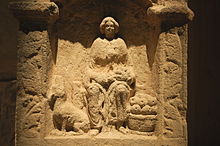
Besides Nerthus, Tacitus elsewhere mentions other important female deities worshiped by the Germanic peoples, such as
In addition to the collective matronae, votive altars from Roman Germania attest a number of individual goddesses.
Another goddess,
Post-Roman era
*Tiwaz/Tyr
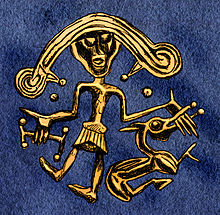
The god *Tiwaz (
Scholars generally believe that Tyr became less and less important in the Scandinavian branch of Germanic paganism over time and had largely ceased to be worshiped by the Viking Age.[198][199] He plays a major role in only one myth, the binding of the monstrous wolf Fenrir, during which Tyr loses his hand.[200]
*Thunraz/Thor
Thor was the most widely known and perhaps the most widely worshiped god in Viking Age Scandinavia.[201] When the days of the week were translated into Germanic, he was associated with Jupiter, so that dies Jovis ("Day of Jupiter") becomes "Thursday" ["day of Thunraz/Thor"]). This contradicts the earlier interpretatio Romana, where Thor is generally thought to be Hercules.[202] Textual sources such as Adam of Bremen as well as the association with Jupiter in the interpretatio Germanica suggest he may have been the head of the pantheon, at least in some times and places.[203] Alternatively, Thor's hammer may have been equated with Jupiter's lightning bolt.[204] Outside of Scandinavia, he appears on the Nordendorf fibulae (6th or 7th century CE) and in the Old Saxon Baptismal Vow (9th century CE).[205] The Oak of Jupiter, destroyed by Saint Boniface among the Chatti in 723 CE, is also usually presumed to have been dedicated to Thor.[201]
Viking age runestones as well as the Nordendorf fibulae appear to call upon Thor to bless objects.
*Wodanaz/Odin
Odin (*Wodanaz) plays the main role in a number of myths as well as well-attested Norse rituals; he appears to have been venerated by many Germanic peoples in the early Middle Ages, though his exact characteristics probably varied in different times and places.
The age of the cult of Odin is disputed.
In Norse myths, Odin plays one of the most important roles of all the gods.
*Frijjō/Frigg
The only major Norse goddess also found in the pre-Viking period is
Other gods
The god
The god
The most important goddess in the recorded Old Norse pantheon was Freyr's sister, Freyja,[240] who features in more myths and appears to have been worshiped more than Frigg, Odin's wife.[241] She was associated with sexuality and fertility, as well as war, death, and magic.[242] It is unclear how old the worship of Freyja is, and there is no indisputable evidence for her or any of the vanir gods in the southern Germanic area.[241] There is considerable debate about whether Frigg and Freyja were originally the same goddess or aspects of the same goddess.[243]
Besides Freyja, many gods and goddesses are only known from Scandinavia, including
Places and objects of worship
Divine images
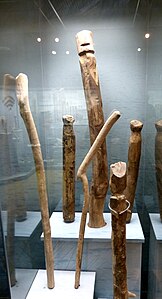
Julius Caesar and Tacitus claimed that the Germani did not venerate their gods in human form; however, this is a topos of ancient ethnography when describing supposedly primitive people.[248][249] Archaeologists have found Germanic statues that appear to depict gods, and Tacitus appears to contradict himself when discussing the cult of Nerthus (Germania chapter 40); the Eddic poem Hávamál also mentions wooden statues of gods, while Gregory of Tours (Historia Francorum II: 29) mentions wooden statues and ones made of stone and metal.[250] Archaeologists have not found any divine statues dating from after the end of the migration period; it is likely that they were destroyed during Christianization, as is repeatedly depicted in the Norse sagas.[251]
Roughly carved wooden male and female figures that may depict gods are frequent finds in bogs;[252] these figures generally follow the natural form of a branch. It is unclear whether the figures themselves were sacrifices or if they were the beings to whom the sacrifice was given.[249] Most date from the first several centuries CE.[253] For the pre-Roman Iron Age, board-like statues that were set up in dangerous places encountered in everyday life are also attested.[254] Most statues were made out of oak wood.[255] Small animal figurines of cattle and horses are also found in bogs; some may have been worn as amulets while others seem to have been placed by hearths before they were sacrificed.[256]
Holy sites from the migration period frequently contain gold
The stone altars of the matronae and Nehalennia show women in Germanic dress, but otherwise follow Roman models, while images of Mercury, Hercules, or Mars do not show any difference from Roman models.
Sacred places

Caesar and Tacitus claimed that the ancient Germans had no temples and only worshipped in sacred groves.[252] However, while groves, trees, bogs, springs, and lakes undoubtedly were seen as holy places by the Germani, there is archaeological evidence for temples.[267] Archaeology also indicates that neolithic structures and Bronze Age tumuli were used as places of worship.[268] Steuer argues that finds of sacrificial places enclosed with a palisade in England indicate that similarly enclosed areas in northern Germany and Jutland may have been holy sites.[266] Large fire pits near settlements, found in many sites including those from the Bronze Age, the pre-Roman Iron Age, and the migration period, probably served as ritual, political, and social locations.[269] Large halls in settlements probably also fulfilled ceremonial religious functions.[270]
Tacitus mentions a temple of the goddess Tamfana in Annales 1.51, and also uses the word templum in reference to Nerthus in Germania, though this could simply mean a consecrated place rather than a building.[271] Later Christian sources refer to temples (fana) used by the Franks, Lombards, continental Saxons, and Anglo-Saxons, while the post-conversion Lex Frisionum (Frisian Law) continued to include punishments for those who broke into or desecrated temples.[272] A temple dedicated to Hercules from the territory of the Batavi at Empel in the Netherlands shows a typical Romano-Celtic building style.[270] Other Roman-style temples dedicated to the matronae are known from the Lower Rhine region.[273]

An early Scandinavian temple has been identified at Uppåkra, modern Sweden.[275] The building, a very large hall with two entrances, was rebuilt on exactly the same site 7 times from 200 to 950 CE.[276] Architecturally, the temple resembles later Scandinavian stave churches in construction.[277] The building was surrounded by animal bones and a few human bones.[278] A similar building has been found at Møllebækvej on Zealand dating from the 3rd century CE,[279] while the later stages of a ritual house at Tissø in Zealand (850-950 CE) likewise resemble a stave church.[280]
The most important description of a Scandinavian temple is of the
Sacred trees, groves, and poles
Sacred trees occur as important symbols in many pre-modern cultures, particularly those of Indo-European origin.
Physical trees or poles could represent either a
Personnel and devotees
Animal symbolism and warrior bands
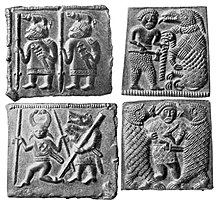
Post-conversion Norse texts mention dedicated groups of warriors, some of whom, the berserkir (berserkers) and ulfheðnar, were associated with bears and wolves respectively. In Ynglinga saga, Snorri Sturluson associates these warriors with Odin.[303] Many scholars argue that warrior bands, with their initiation rites and forms of organization, can be traced to the time of Tacitus, who discusses several warrior bands and societies among the Germani. These scholars further argue that these bands can be traced further back to Proto-Indo-European precursors to some extent. Other scholars, such as Hans Kuhn, dispute continuity between Norse and earlier warrior bands.[304] Inhumation and cremation graves containing bear claws, teeth, and hides are found throughout the Germanic-speaking area, being especially common on the Elbe from 100 BCE to 100 CE and in Scandinavia from the 2nd to 5th centuries CE; these may be connected to the warrior societies.[305]
Archaeologists have found metal objects, especially on weapons and brooches,[306] decorated with animal art and dating from the 4th to the 12th centuries CE in Scandinavia.[307] Animals depicted include snakes, birds of prey, wolves, and boars.[306] Some scholars have discussed these images as related to shamanism, while others view animal art as similar to Skaldic kennings, capable of expressing both Christian and pagan meanings.[308]
Ritual specialists
Scholars are divided as to the nature and function of Germanic ritual specialists: many religious studies scholars believe that there was originally no class of priests and cultic functions were mostly carried out by kings and chieftains; many philologists, however, argue on the basis of reconstructed words for "priest" that a specialized class of priests existed.[310] Caesar says the Germani had no druids, while Tacitus mentions several priests.[311] Roman sources do not otherwise mention Germanic cultic functionaries.[202] Later descriptions of similar rituals to those mentioned in Tacitus do not mention any ritual specialists; however, it is reasonable to assume that they continued to exist.[312] While ritual specialists in Viking Age Scandinavia may have had defining insignia such as staffs and oath rings, it is unclear if they formed a hierarchy and they seem to have fulfilled non-cultic roles in society as well.[313]
Caesar and Tacitus both mention women engaged in casting lots and prophecy and there are some other indications of female ritual specialists.[314] Tacitus and the Roman writer Cassius Dio (163-c. 229 CE) both mention several seeresses by name, while an ostracon from Egypt attests one living in the second century CE.[315] A female ritual specialist named Gambara appears in Paul the Deacon (8th century).[316] A gap in the historical record occurs until the North Germanic record began over a millennium later, when the Old Norse sagas frequently mention female ritual specialists among the North Germanic peoples, both in the form of priestesses and diviners.[317] Both Tacitus and Eiríks saga rauða mention the seeress prophesying from a raised platform, while Eiríks saga rauða also mentions the use of a wand.[318][319]
Practices
Burial practices
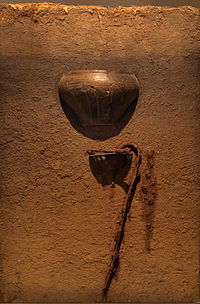
Some insight into Germanic religion can be provided by burial customs,
Often, urns were covered with stones and then surrounded by circles of stones.[324] The urns of the dead were often placed in a mortuary house, which may have served as a cultic structure.[333] Cemeteries might be placed around or reuse old Bronze Age barrows, and later placed near Roman ruins and roads, possibly to ease the passing of the dead into the afterlife.[334][335][336] Some graves included burials of horses and dogs;[337] horses may have been meant as conveyances to the afterlife.[91] Burials with dogs are found over a wide area through the migration period; it is possible that they were meant either to protect the deceased in the afterlife or to prevent the return of the dead as a revenant.[337]
After 1 CE, inhumation burials in large burial mounds with wooden or stone grave chambers, which contained expensive grave goods and were separate from the normal cemeteries, begin to appear across the entire Germanic area.[338] [339] By the 3rd century, elite burials are attested from Norway to Slovakia, with a large number appearing on Jutland.[340] These graves usually include dishes and tableware: this may have been meant for the deceased to use in the afterlife or may have been used in a funerary meal.[341] In the 400s CE, the practice of erecting elite Reihengräber ("row graves") appears among the continental Germanic peoples: these grave were arranged in rows and contain large amounts of gold, jewelry, ornaments, and other luxury items. Unlike cremation cemeteries, only a few hundred individuals are found buried in Reihengräber cemeteries.[342] Elite chamber graves become especially common in Scandinavia in the 9th and 10th centuries, in which the body of deceased was sometimes buried seated with objects in the hands or on the lap.[343]

Stones set up in the shape of a ship are known from Scandinavia, where they are sometimes surrounded by graves or occasionally contain one or more cremations.[345][346] The earliest ship burial is found in Jutland from the late Roman Imperial period. Another earlier burial is from outside Scandinavia, near Wremen on the Weser river in northern Germany from the 4th or 5th century CE.[347] Ship burials are attested in England from around 600 CE and from across Scandinavia and areas where Scandinavians traveled beginning around the same time and for centuries afterward.[348][349] In some cases, the deceased was evidently cremated in the ship before a mound was thrown up over it, as is described by Ahmad ibn Fadlan for the Rus'.[350] Scholars debate the meaning of these burials: the ship may have been a means of transport to the next life or may have represented a feasting hall. Parts of the ships were often left uncovered for extended periods of time.[351]
Divination
Various practices for divining the future are attested for Germanic paganism, some of which were likely only practiced in a particular time or place.[352] The main sources on Germanic divination are Tacitus, Christian early medieval texts of the missionary period (such as penitentials and Frankish capitularies), and various texts describing Scandinavian practices; however, the value of all of these sources for genuine Germanic practices is debated.[353]

The casting and drawing of lots to determine the future is well-attested among the Germanic peoples in medieval and ancient texts; linguistic analysis confirms that it was an old practice.[355] As of 2002, about 160 lots made of various materials have been found in Roman-era and migration-period archaeological sites.[356] The most detailed description of Germanic lots is found in Tacitus, Germania, chapter 10. According to Tacitus, the Germani cast lots, made from the wood of fruit-bearing trees and marked with signs, onto a white sheet, after which three lots were drawn by either the head of the family or a priest.[355] While the signs Tacitus mentions have been interpreted as Runes, most scholars believe they were simple symbols.[357] Thirteenth-century Icelandic sources also attest the drawing of lots carved with signs; however, there is debate about whether these late sources represent a form of ordeal that was introduced with Christianity or a continuation of Germanic practice.[358]
Another important form of divination involved animals. The interpretation of the actions of birds is a common practice across the world and is well attested for the Germani and the Norse.
A few other methods of divination are also attested. Tacitus mentions duels as a method of learning the future; while Norse sources attest many duels, none are obviously used for divination.[363] Roman and Christian sources sometimes claimed that the Germanic peoples used the blood or entrails of human sacrifices to divine the future. This may derive from ancient topoi rather than reality,[364] although blood played an important role in pagan ritual. Norse sources include additional forms of divination such as a form of necromancy known as útiseta, as well as seiðr rituals.[365]
Feasts and festivals
The evidence suggests that the Germanic peoples had recurrent sacrifices and festivals at certain times of year.[366] Often these feasts involved sacrifice at communal meals, ritual drinking, as well as processions and divination.[367] Almost all information on Germanic religious festivals concerns Western Scandinavia,[368] but Tacitus mentions a sacrifice to the goddess Tamfana took place in the autumn, while Bede mentions a festival called Mōdraniht that occurred in early February,[366] and Jonas of Bobbio's Life of Saint Columbanus (640s) mentions a festival to Vodan (Odin) held by the Suebi that involved the drinking of beer.[368] On the basis of several informants and possibly textual sources, Adam of Bremen describes a Swedish sacrificial festival held every nine years at the Temple of Uppsala, while Thietmar of Merseburg mentions a similar festival taking place each January at Lejre in Zealand.[369] The Swedish feast known as Disting took place in February, the same time as the Old English modraniht; the only other widely attested festival is Yule around Christmas. Snorri Sturluson mentions three additional festivals in Ynglinga saga: a festival at the beginning of winter for a good harvest, one at midwinter for fertility, and one at the beginning of summer for victory. The summer festival is not attested elsewhere, but Rudolf Simek argues that the winter festival was probably in honor of the ancestors while another festival at spring was for fertility.[366]
Magic

Magic is an element of religion that intends to influence the world with the help of the otherworldly by using particular rituals, means, or words.
Migration-age inscriptions on bracteates and later rune stones contain a number of early magical words and formulas, the best attested of which, alu, is found on multiple objects from 200 to 700 CE.[380] Post-conversion Christian sources from continental Europe mention forms of magic including amulets, charms, "witchcraft", divination, and especially weather magic.[381] Old Norse mythology and post-conversion literature also attest various forms of magic, including divination, magic affecting nature (weather or otherwise), spells to make warriors impervious to weapons, spells to strengthen weapons, and spells to harm and distress others.[382]
The term "charm" is used to mean magical poetry, which could be blessings or curses; most attested charms are blessings and seek protection, defense against magic or sickness, and healing; the only form of curses attested outside of literature are calls for death.
Ritual procession
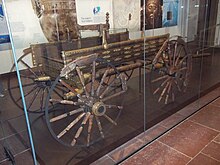
Ritual processions of the idol of a god in some form of vehicle, usually a wagon, are attested in many religions of Europe and Asia.[391] Various archaeological finds indicate the existence of such rituals in Scandinavia as early as the Bronze Age.[392] Ships may also have been used for processions, such as the ship found at Oberdorla moor in Thuringia from the Migration Period. The processions are usually interpreted as fertility rites.[393] An image of a Viking-age process of some sort, including men, women, and carriages, is provided by the Oseberg tapestry fragments.[394]
The earliest written source for a ritual procession in Germanic religion is in Tacitus's Germania, chapter 40, when he describes the worship of Nerthus.[395] According to Tacitus, Nerthus's idol is drawn around the land for several days on a cart pulled by cows, before being brought to a lake and cleaned by slaves, who are then drowned in the lake.[396] Tacitus's description is reminiscent of archaeological finds of highly decorated wagons in water and in burials from southern Scandinavia roughly contemporary to Tacitus.[397][398] A similar ritual is attested for the Goths, who forced Christians to participate during the Gothic persecution of Christians (369-372 CE), as well as among the Franks by Gregory of Tours, although the latter sets his ritual in pre-Germanic Gaul for an eastern goddess.[399] The Frankish Merovingian kings are also attested as having been carried by an oxcart to assemblies, something reminiscent of Tacitus's description.[400][401] An extensive description of a ritual procession for the god Freyr is found in the Flateyjarbók (1394); it describes Freyr being driven around in a wagon to ensure a good harvest.[402] This and several other post-conversion Scandinavian sources on such processions may derive from oral tradition of the worship of Freyr.[403]
Sacrifices

Archaeology provides evidence of sacrificial offerings of various types. Deposits of valuable objects, including of gold and silver, that were buried in the earth are frequently attested for the period of 1-100 CE. While these objects may have been buried with the intention of their being removed again at a later date, it is also possible that they were intended as sacrifices for the gods or for use in the afterlife.[405] Metal objects deposited in springs are attested from Bad Pyrmont and Duchcov, as well as such objects deposited in bogs.[406] There are also examples of hair, clothing, and textiles from c. 500 BCE-200 CE found in Scandinavian wetlands.[407] Gregory of Tours, when describing a Frankish shrine near Cologne, depicts worshipers leaving wooden carvings of parts of the human body whenever they felt pain.[312]
Animal sacrifices are attested by bones in various holy places associated with the
Human sacrifices are mentioned periodically by Roman authors, usually to stress elements that they found shocking or abnormal.

Sacrifices of the weapons of defeated enemies have been uncovered in bogs in Jutland as well as in rivers throughout Germania:[420] such sacrifices probably occurred in other parts of Germania on dry land. Tacitus reports a similar sacrifice and destruction of weapons performed in the forest after Arminius's victory over the Romans at the Battle of the Teutoburg Forest.[252] Large deposits of weapons are attested from 350 BCE to 400 CE, with smaller deposits continuing to be made until 600 CE.[421] Deposits of various sizes were common and often included objects besides weapons, even warships that had been burned and destroyed.[422][423] They appear to be from a ritual performed over a defeated enemy to commit the weapons to the gods.[422] There is no archaeological evidence for what happened to the warriors who bore the weapons, but Roman sources describe them as being sacrificed as well.[424][425] A possible exception is the site of Alken Enge bog in Jutland: it contains the crushed and dismembered bodies of about 200 men, aged 13–45 years, who seem to have died on a battlefield.[426] No later Scandinavian sources mention rituals associated with the destruction of weapons, implying that these rites had died out and been forgotten at an early date.[427]
Variations of Germanic paganism
- Anglo-Saxon paganism
- Continental Germanic mythology
- Frankish mythology
- Gothic paganism
- Old Norse religion
See also
- Ancient Celtic religion
- Ancient Greek religion
- Ancient Iranian religion
- Germanic mythology
- Hittite mythology and religion
- Historical Vedic religion
- Religion in ancient Rome
- Scythian religion
- Slavic paganism
Notes
- ^ Note: the divine names marked with an asterisk are unattested in historical records, but are otherwise reconstructed via the comparative method in linguistics.
- ^ Tacitus’s detailed description of the Germanic religion was written around 100 AD. His ethnographic descriptions in Germania remain contested by modern scholars. According to Tacitus, the Germanic peoples sacrificed both humans and other animals to their gods.[34] He also tells that the largest group, the Suebi, also sacrificed Roman prisoners of war to a goddess whom he identified with Isis.[34]
- ^ One of the oldest written sources on Germanic religion is Julius Caesar's Commentarii de Bello Gallico, where he compares the very intricate Celtic customs with what he perceived were very "primitive" Germanic traditions. Caesar wrote: The German way of life is very different. They have no druids to preside over matter related to the divine, and they do not have much enthusiasm for sacrifices. They count as gods only those phenomenon that they can perceive and by whose power they are plainly helped, the Sun, Fire, and Moon; others they do not know even from hearsay. Their whole life is spent on hunting and military pursuits." (Caesar, Gallic War 6.21.1–6.21.3)[38]
References
- ^ Simek 1993, p. 278.
- ^ Hultgård 2010a, p. 863.
- ^ Maier 2018, p. 99.
- ^ Simek 2004, p. 74.
- ^ Hultgård 2010a, pp. 865–866.
- ^ Zernack 2018, pp. 527–528.
- ^ Hultgård 2010a, pp. 866–867.
- ^ a b Schjødt 2020b, p. 250.
- ^ Schjødt 2020b, p. 265.
- ^ Pohl 2004, p. 83.
- ^ Maier 2010b, p. 591.
- ^ a b c Hultgård 2010a, p. 872.
- ^ Schjødt 2020a, p. 246.
- ^ Timpe & Scardigli 2010, p. 385.
- ^ Schjødt 2020a, p. 241.
- ^ Schjødt 2020a, pp. 243–244.
- ^ a b Maier 2010a, p. 573.
- ^ Zernack 2018, p. 533.
- ^ Gunnell 2020a, pp. 197–198.
- ^ Demandt & Goetz 2010, p. 468-470.
- ^ Zernack 2018, p. 537.
- ^ Gunnell 2020a, pp. 201–202.
- ^ a b Brather, Heizmann & Patzold 2021, p. 27.
- ^ Gunnell 2020a, pp. 198–199.
- ^ Gunnell 2020a, pp. 199–201.
- ^ Lindow 2020d, p. 1095.
- ^ Hultgård 2010a, pp. 871–872.
- ^ Schjødt 2020b, pp. 255–256.
- ^ Hultgård 2010a, pp. 872–873.
- ^ Schjødt 2020b, p. 256.
- ^ Steuer 2021, p. 647.
- ^ Schjødt 2020b, p. 257.
- ^ Simek 1993, p. x.
- ^ a b Tacitus 2009, p. 42.
- ^ Schjødt 2020b, pp. 257–258.
- ^ Beare 1964, p. 72–73.
- ^ a b Ebenbauer 1984, p. 512.
- ^ Caesar 2017, p. 187.
- ^ Dunn 2013, pp. 11–12.
- ^ Simek 1993, p. 33.
- ^ Ebenbauer 1984, pp. 514–515.
- ^ Lindow 2020c, pp. 67–101.
- ^ Egeler 2020, p. 291.
- ^ Koch 2020.
- ^ Egeler 2020, pp. 299–300.
- ^ Egeler 2020, pp. 302–309.
- ^ Maier 2010d, pp. 921–922.
- ^ Simek 2020a, p. 274.
- ^ Simek 2020a, pp. 286–287.
- ^ Ahn, Padberg & Hultgård 2010, pp. 438–440.
- ^ Ahn, Padberg & Hultgård 2010, pp. 240–246.
- ^ Maier 2010d, p. 925-926.
- ^ a b Hultgård 2010c, p. 485, 488-489.
- ^ a b Nordvig 2020a, p. 989.
- ^ a b Hultgård 2010c, pp. 484–485.
- ^ Nordvig 2020a, p. 993.
- ^ Wolters 2001, p. 467-468.
- ^ a b Schjødt 2020a, p. 239.
- ^ a b Wolters 2001, p. 471.
- ^ a b Simek 2004, p. 91.
- ^ a b Kuhlmann 2022, p. 328.
- ^ Hultgård 2010c, pp. 484–485, 505.
- ^ Hultgård 2010c, p. 485.
- ^ Hultgård 2010c, pp. 485–486.
- ^ Schjødt 2020b, pp. 266–267.
- ^ Schjødt 2020b, p. 267.
- ^ Nordvig 2020a, p. 995.
- ^ Hultgård 2020, p. 1022-1023.
- ^ Schjødt 2010, pp. 987–988.
- ^ Schjødt 2010, pp. 983–984.
- ^ Schjødt 2010, p. 985.
- ^ Hultgård 2020, p. 1025.
- ^ Nordvig 2020b, p. 1012-1013.
- ^ a b Simek 1993, p. 53.
- ^ Nordvig 2020b, p. 1001.
- ^ Nordvig 2020b, p. 1014.
- ^ a b Simek 1993, p. 214.
- ^ a b c Simek 1993, p. 54.
- ^ Andrén 2014, p. 37.
- ^ Nordvig 2020b, p. 1004-1005.
- ^ Simek & Reichstein 2010, pp. 290–291.
- ^ Simek 2010a, p. 16-17.
- ^ Lindow 2020a, pp. 948–949.
- ^ Simek 1993, p. 374.
- ^ Simek 2010a, p. 17-18.
- ^ Lindow 2020a, pp. 936–937.
- ^ Lindow 2020a, p. 949-950.
- ^ Lindow 2020a, pp. 930–931.
- ^ Lindow 2020a, p. 750.
- ^ Lindow & Andrén 2020, pp. 907–908.
- ^ a b Lindow & Andrén 2020, p. 915.
- ^ a b Hultgård 2010d, p. 944.
- ^ Lindow & Andrén 2020, p. 925.
- ^ Hultgård 2010d, p. 949.
- ^ a b Lindow & Andrén 2020, p. 898.
- ^ Simek 1993, p. 138.
- ^ Lindow 2001, p. 172.
- ^ Lindow & Andrén 2020, p. 899.
- ^ Simek 1993, p. 137.
- ^ Simek 1993, p. 347.
- ^ Price 2020, p. 861-862.
- ^ Daxelmüller 2010a, p. 1180.
- ^ Simek 1993, p. 372.
- ^ a b Schuppener 2010, p. 1620.
- ^ Simek 1993, p. 232.
- ^ Beck 1998, p. 481.
- ^ Schuppener 2010, pp. 1620–1621.
- ^ Simek 1993, pp. 232–233.
- ^ Maier 2010a, p. 567.
- ^ Lindow & Schjødt 2020a, p. 953.
- ^ Lindow & Schjødt 2020a, p. 952.
- ^ Maier 2010a, p. 571.
- ^ Lindow & Schjødt 2020a, p. 958.
- ^ Green 1998, pp. 16–20.
- ^ Green 1998, p. 13.
- ^ a b Reichert 2010a, p. 940.
- ^ a b Simek 1993, p. 3.
- ^ Nahl 2014.
- ^ Maier 2010b, p. 589-590.
- ^ Simek 1993, p. 4.
- ^ Lindow 2020b, p. 1033.
- ^ Lindow 2020a, pp. 1033–1036.
- ^ Clunies Ross 2020, pp. 1541–1542.
- ^ Clunies Ross 2020, p. 1554.
- ^ Clunies Ross 2020, p. 1528, 1530.
- ^ Clunies Ross 2020, p. 1530.
- ^ a b Petzoldt 2010a, p. 602.
- ^ a b Clunies Ross 2020, p. 1528.
- ^ Petzoldt 2010a, p. 603.
- ^ Simek 1993, p. 107.
- ^ Clunies Ross 2020, p. 1527.
- ^ Nordvig 2020b, pp. 1010–1011.
- ^ Daxelmüller 2010a, p. 1178.
- ^ Homann & Capelle 2010, p. 273.
- ^ Kuhn 2010, p. 258.
- ^ Gunnell 2020c, p. 1575-1576.
- ^ Gunnell 2020c, p. 1571.
- ^ a b c d Simek 1993, p. 68.
- ^ Simek 1993, p. 73.
- ^ Niles 2013, p. 311.
- ^ Berger 2010, p. 1197.
- ^ Gunnell 2020b, p. 1559.
- ^ Berger 2010, pp. 1197–1198.
- ^ Berger 2010, p. 1199.
- ^ Kuhn 2010, p. 260.
- ^ Niles 2013, pp. 311–312.
- ^ Simek & Reichstein 2010, p. 291.
- ^ Homann & Capelle 2010, pp. 269–270.
- ^ Homann & Capelle 2010, p. 263-266.
- ^ Ogden 2021, pp. 309–319.
- ^ Simek & Reichstein 2010, p. 288.
- ^ Beck 1998, p. 480.
- ^ Vikstrand 2020, pp. 121–125.
- ^ Beck 1998, p. 483-484.
- ^ Simek 2004, pp. 82–83.
- ^ a b Maier 2010a, p. 568.
- ^ Simek 1993, p. 141-142.
- ^ Maier 2010d, pp. 922–923.
- ^ a b Schjødt 2020b, p. 262.
- ^ Pohl 2004, pp. 81–82.
- ^ Janson 2018, p. 12.
- ^ Simek 2020a, pp. 283.
- ^ Simek 2020a, p. 275.
- ^ Simek 2020a, p. 284.
- ^ Steuer 2021, p. 608.
- ^ Shaw 2007.
- ^ Rosenfeld & Hauck 2010, pp. 969–970.
- ^ Simek 1993, p. 7.
- ^ Andrén 2020a, pp. 1453–1455.
- ^ Andrén 2020a, pp. 1455–1456.
- ^ Simek 1993, pp. 59–60, 139.
- ^ Andrén 2020a, p. 1463.
- ^ a b Lindow 2021, pp. 33.
- ^ a b Steuer 2021, p. 649.
- ^ a b c Simek 2020b, p. 1481.
- ^ Steuer 2021, pp. 649–650.
- ^ Simek 2020b, p. 1485.
- ^ Simek 2020b, p. 1488.
- ^ Simek 2020b, pp. 1490–1491.
- ^ a b Lindow 2020e, p. 1497.
- ^ Naumann 2010, pp. 988–989.
- ^ Naumann 2010, p. 989.
- ^ Dunn 2013, p. 21.
- ^ Shaw 2011, pp. 49–72, 73–97.
- ^ Rijksmuseum van Oudheiden.
- ^ Zimmer & Hultgård 2010, p. 176.
- ^ Simek 2020b, p. 1487.
- ^ Simek 1993, p. 228.
- ^ Steuer 2021, p. 650.
- ^ a b c Simek 2004, p. 83.
- ^ Simek 1993, p. 229.
- ^ Simek 1993, pp. 153–154.
- ^ Lindow 2020f, p. 1351.
- ^ Schjødt 2020a, p. 230.
- ^ Simek 1993, p. 337.
- ^ Simek 1993, p. 334.
- ^ Schjødt 2020a, p. 235.
- ^ Hultgård 2010f, pp. 931.
- ^ Simek 1993, pp. 337–338.
- ^ Lindow 2020f, p. 1346.
- ^ a b Lindow 2020d, p. 1051.
- ^ a b c Simek 2020a, p. 280.
- ^ Lindow 2020d, pp. 1091–1092.
- ^ a b Simek 2004, p. 82.
- ^ Beck 2010, pp. 1–2.
- ^ Beck 2010, pp. 2–3.
- ^ Lindow 2020d, p. 1052.
- ^ Beck 2010, p. 10.
- ^ Lindow 2020d, pp. 1104–1105.
- ^ Lindow 2020d, p. 1107-1108.
- ^ Düwel, Nedoma & Oehrl 2020, p. 459.
- ^ Düwel, Nedoma & Oehrl 2020, p. 470.
- ^ Schjødt 2020e, pp. 1123–1124.
- ^ Simek 2020a, p. 281.
- ^ Schjødt 2020e, p. 1129=1130.
- ^ Pohl 2004, p. 81.
- ^ Brooks 2023.
- ^ Steuer 2021, pp. 608–609.
- ^ Steuer 2021, p. 652.
- ^ Schjødt 2020e, p. 1123.
- ^ a b Janson 2018, pp. 15–17.
- ^ Simek 1993, pp. 473–374.
- ^ Janson 2018, p. 17.
- ^ Steuer 2021, p. 646.
- ^ Dunn 2013, p. 17.
- ^ Simek 2004, p. 90.
- ^ Ásdísardóttir 2020b, p. 1381-1382.
- ^ Simek 1993, p. 93.
- ^ Ásdísardóttir 2020b, p. 1389.
- ^ Ásdísardóttir 2020b, p. 1384.
- ^ Ásdísardóttir 2020b, p. 1387.
- ^ Simek 1993, pp. 84, 278–279.
- ^ Simek 1993, p. 26, 29.
- ^ Simek 1993, p. 91.
- ^ Simek 1993, p. 92.
- ^ Simek 1993, p. 173.
- ^ Simek 1993, p. 89.
- ^ Lindow & Schjødt 2020b, p. 1413.
- ^ Simek 1993, p. 276.
- ^ Simek 1993, p. 90.
- ^ a b Ásdísardóttir 2020a, p. 1273.
- ^ Ásdísardóttir 2020a, pp. 1301–1302.
- ^ Davidson 1998, p. 10.
- ^ Simek 2004, p. 88.
- ^ Lindow & Schjødt 2020b, p. 1452.
- ^ Rubel 2016, p. 48.
- ^ Steuer 2021, pp. 641–642.
- ^ Schjødt 2020b, p. 264.
- ^ a b Steuer 2021, p. 638.
- ^ Capelle & Maier 2010, pp. 649–650.
- ^ Capelle & Maier 2010, p. 656.
- ^ a b c Steuer 2021, p. 615.
- ^ Steuer 2021, p. 639.
- ^ Capelle & Maier 2010, p. 653.
- ^ Capelle & Maier 2010, p. 657.
- ^ Steuer 2021, p. 645.
- ^ Steuer 2021, p. 630.
- ^ Maier 2010c, pp. 581–582.
- ^ Heizmann 2012, pp. 696–968.
- ^ Heizmann 2012, pp. 702–704.
- ^ Heizmann 2012, p. 706.
- ^ Maier 2010c, p. 581.
- ^ Steuer 2021, p. 614.
- ^ Steuer 2021, p. 644.
- ^ Steuer 2021, p. 648.
- ^ a b Steuer 2021, p. 617.
- ^ Steuer 2021, p. 629.
- ^ Steuer 2021, p. 616.
- ^ Steuer 2021, pp. 636–637.
- ^ a b Steuer 2021, pp. 657–658.
- ^ Sundqvist & Seitz 2010, pp. 656–657.
- ^ Sundqvist & Seitz 2010, pp. 657–660.
- ^ Simek 2004, p. 86.
- ^ Schjødt 2020c, p. 633.
- ^ Steuer 2021, p. 656.
- ^ Zachrisson & Andrén 2020, p. 699.
- ^ Steuer 2021, p. 653.
- ^ Zachrisson & Andrén 2020, pp. 699–700.
- ^ Steuer 2021, p. 654.
- ^ Zachrisson & Andrén 2020, p. 703.
- ^ Sundqvist & Seitz 2010, p. 671.
- ^ Sundqvist & Seitz 2010, pp. 671–672.
- ^ Simek 2004, p. 85.
- ^ Zachrisson & Andrén 2020, pp. 703–704.
- ^ Price 2020a, p. 114.
- ^ Zachrisson & Andrén 2020, pp. 705.
- ^ Cusack 2011, p. 25.
- ^ Reichert 2010b, pp. 6–7.
- ^ Cusack 2011, pp. 91–94.
- ^ Reichert 2010b, pp. 9–12.
- ^ Reichert 2010b, pp. 17–20.
- ^ Nordvig 2020b, p. 1015.
- ^ Andrén 2014, p. 57.
- ^ Cusack 2011, pp. 8–11.
- ^ Springer & Maier 2010, p. 1011.
- ^ Simek 1993, p. 182.
- ^ Cusack 2011, p. 53-54.
- ^ Cusack 2011, pp. 95–97.
- ^ a b Andrén 2014, p. 49.
- ^ Niles 2013, p. 313.
- ^ Simek 1993, p. 176.
- ^ Schjødt 2020d, pp. 571–572.
- ^ Schjødt 2020d, pp. 576–577.
- ^ Schjødt 2020d, p. 561.
- ^ Steuer 2021, pp. 650–651.
- ^ a b Andrén 2020b, p. 185.
- ^ Andrén 2020b, p. 165.
- ^ Andrén 2020b, pp. 185–186.
- ^ Sundqvist 2020, p. 768.
- ^ Sundqvist 2020, pp. 740–742.
- ^ Sundqvist 2020, pp. 743–744.
- ^ a b Dunn 2013, p. 27.
- ^ Sundqvist 2020, p. 779.
- ^ Sundqvist 2020, p. 446-747.
- ^ Simek 2020a, pp. 278–280.
- ^ Sundqvist 2020, p. 747.
- ^ Sundqvist 2020, pp. 773–779.
- ^ Orchard 1997, pp. 174.
- ^ Simek 1993, p. 326.
- ^ a b Steuer 2021, p. 842.
- ^ Steuer 2021, p. 611.
- ^ Sundqvist & Kaliff 2010, p. 73.
- ^ Todd 1999, p. 80.
- ^ a b Steuer 2021, p. 837.
- ^ Price 2020, pp. 869–870.
- ^ Steuer 2021, p. 611, 837.
- ^ Price 2020, pp. 872–873.
- ^ Steuer 2021, pp. 841–842.
- ^ Steuer 2021, pp. 841.
- ^ Price 2020, p. 870.
- ^ Steuer 2021, p. 612.
- ^ Todd 1999, pp. 82–83.
- ^ Steuer 2021, p. 613.
- ^ Steuer 2021, p. 839.
- ^ Price 2020, pp. 886–889.
- ^ Dunn 2013, pp. 146–147.
- ^ a b Steuer 2021, p. 843.
- ^ Steuer 2021, pp. 906–908.
- ^ James 2014, p. 130.
- ^ Steuer 2021, p. 969.
- ^ Steuer 2021, p. 975.
- ^ James 2014, pp. 131–133.
- ^ Price 2020, pp. 880–882.
- ^ Carver 1998, p. 121.
- ^ Todd 1999, p. 82.
- ^ Price 2020, p. 877.
- ^ Capelle 2010, pp. 102–103.
- ^ Carver 1998, pp. 120–121, 164.
- ^ Price 2020, p. 886.
- ^ Price 2020, pp. 882–884, 859–860.
- ^ Price 2020, p. 885.
- ^ Schjødt 2020c, p. 241.
- ^ Pesch, Dickmann & Lübke 2010, pp. 268–270.
- ^ Brentführer, "069 Orakelstäbchen".
- ^ a b Pesch, Dickmann & Lübke 2010, pp. 270–271.
- ^ Pesch, Dickmann & Lübke 2010, pp. 280–281.
- ^ Schjødt 2020c, p. 638.
- ^ Pesch, Dickmann & Lübke 2010, p. 271.
- ^ Pesch, Dickmann & Lübke 2010, pp. 272–273.
- ^ Schjødt 2020c, p. 638-639.
- ^ a b Pesch, Dickmann & Lübke 2010, pp. 273–274.
- ^ Schjødt 2020c, p. 639.
- ^ Schjødt 2020c, p. 640.
- ^ Pesch, Dickmann & Lübke 2010, pp. 275–276.
- ^ Schjødt 2020c, pp. 240–241.
- ^ a b c Simek 2004, p. 87.
- ^ Sundqvist & Kaliff 2010, p. 76.
- ^ a b Hultgård 2010a, p. 880.
- ^ Hultgård 2010a, pp. 880–882.
- ^ Düwel, Nedoma & Oehrl 2020, p. 723.
- ^ Düwel, Nedoma & Oehrl 2020, pp. 725–726.
- ^ Düwel, Nedoma & Oehrl 2020, p. 736.
- ^ Mitchell 2020, p. 643.
- ^ Petzoldt 2010b, pp. 290–291.
- ^ Mitchell 2020, pp. 645–646.
- ^ Haid & Dillmann 2010, p. 1714.
- ^ Petzoldt 2010b, p. 293.
- ^ Simek 1993, p. 242.
- ^ Düwel, Nedoma & Oehrl 2020, p. CXXX.
- ^ Simek 2010b, pp. 885–885.
- ^ Petzoldt 2010b, p. 291-294.
- ^ Haid & Dillmann 2010, pp. 1718–1725.
- ^ Simek 2010b, p. 883.
- ^ Simek 2010b, pp. 882–883.
- ^ Simek 2010b, pp. 889–891.
- ^ Mitchell 2020, p. 663.
- ^ Simek 2010b, p. 887-888.
- ^ Simek 2010b, p. 888-889.
- ^ Gunnell 2020a, p. 199.
- ^ Steuer 2021, p. 640.
- ^ Hultgård 2010e, pp. 874–875.
- ^ Daxelmüller 2010b, pp. 522.
- ^ Daxelmüller 2010b, p. 523.
- ^ Schjødt 2020c, p. 631.
- ^ Hultgård 2010e, p. 875.
- ^ Simek 2020a, p. 277.
- ^ Steuer 2021, pp. 640–641.
- ^ Egg & Kaul 2010, p. 957.
- ^ Dunn 2013, pp. 23–24.
- ^ Steuer 2021, p. 641.
- ^ Hultgård 2010e, pp. 878–879.
- ^ Hultgård 2010e, pp. 881–882.
- ^ Hultgård 2010e, p. 883.
- ^ Steuer 2021, pp. 631.
- ^ Steuer 2021, pp. 632–633.
- ^ Steuer 2021, pp. 631–632.
- ^ Zachrisson & Andrén 2020, pp. 687–688.
- ^ Steuer 2021, pp. 630–631, 636.
- ^ Zachrisson & Andrén 2020, p. 680.
- ^ Lindow 2020c, p. 91.
- ^ Steuer 2021, pp. 635–636.
- ^ Steuer 2021, pp. 612–613.
- ^ Hultgård 2010b, p. 535.
- ^ Todd 1999, p. 110.
- ^ Steuer 2021, p. 620.
- ^ Zachrisson & Andrén 2020, p. 684.
- ^ Hultgård 2010b, pp. 1072–1074.
- ^ a b Hultgård 2010b, p. 1088.
- ^ a b Schjødt 2020c, p. 627.
- ^ Steuer 2021, pp. 757–758.
- ^ Zachrisson & Andrén 2020, p. 689.
- ^ a b Simek 2004, p. 76.
- ^ Steuer 2021, pp. 619–620.
- ^ Simek 2004, p. 77.
- ^ Hultgård 2010b, pp. 1089–1090.
- ^ Zachrisson & Andrén 2020, p. 687.
- ^ Zachrisson & Andrén 2020, p. 692.
Bibliography
- Ahn, Gregor; Padberg, Lutz E. V.; Hultgård, Anders (2010) [2005]. "Synkretismus". Germanische Altertumskunde Online.
- Andrén, Anders (2014). Tracing Old Norse Cosmology. The World Tree, Middle Earth, and the Sun in Archaeological Perspectives. Nordic Academic Press.
- ISBN 978-2-503-57489-9.
- ISBN 978-2-503-57489-9.
- Ásdísardóttir, Ingunn (2020a). "Freyja". In Schjødt, Jens Peter; Lindow, John; Andrén, Anders (eds.). The Pre-Christian Religions of the North: History and Structures. Vol. 3. Brepols. pp. 1273–1302. ISBN 978-2-503-57489-9.
- Ásdísardóttir, Ingunn (2020b). "Frigg". In Schjødt, Jens Peter; Lindow, John; Andrén, Anders (eds.). The Pre-Christian Religions of the North: History and Structures. Vol. 3. Brepols. pp. 1381–1389. ISBN 978-2-503-57489-9.
- Beare, W. (1964). "Tacitus on the Germans". Greece & Rome. 11 (1). Cambridge University Press on behalf of The Classical Association: 64–76. S2CID 163536034.
- Beck, Heinrich (1998). "Probleme einer völkerwanderungszeitlichen Religionsgeschichte". In Greuenich, Dieter (ed.). Die Franken und die Alemannen bis zur "Schlacht bei Zülpich" (496/97). de Gruyter. pp. 475–488. S2CID 181676468.
- Beck, Heinrich (2010) [1986]. "Donar-Þórr". Germanische Altertumskunde Online. de Gruyter.
- Berger, Karl C. (2010) [2007]. "Zwerge". Germanische Altertumskunde Online. de Gruyter.
- S2CID 233770774.
- Brentführer, Stefan. "069 Orakelstäbchen". Landschaftsverband Westfalen-Lippe (LWL). Retrieved 12 October 2022.
- Brooks, James (2023). "Oldest reference to Norse god Odin found in Danish treasure". ABC News. Retrieved 8 March 2023.
- Caesar, Julius (2017). "Gallic War". In Raaflaub, Kurt A. (ed.). The Landmark Julius Caesar—The Complete Works: Gallic War, Civil War, Alexandrian War, African War, and Spanish War. Translated by Kurt A. Raaflaub. New York: Pantheon Books. ISBN 978-0-30737-786-9.
- Capelle, Torsten (2010) [2004]. "Schiffsbestattungen". Germanische Altertumskunde Online. de Gruyter.
- Capelle, Torsten; Maier, Bernhard (2010) [2000]. "Idole und Idolatrie". Germanische Altertumskunde Online. de Gruyter.
- Carver, M. O. H. (1998). Sutton Hoo: Burial Ground for Kings?. University of Pennsylvania Press. ISBN 0812234553.
- Clunies Ross, Margaret (2020). "Giants". In Schjødt, Jens Peter; Lindow, John; Andrén, Anders (eds.). The Pre-Christian Religions of the North: History and Structures. Vol. 3. Brepols. pp. 1527–1557. ISBN 978-2-503-57489-9.
- ISBN 978-1-4438-2857-4.
- ISBN 0-415-13610-5.
- Daxelmüller, Christoph (2010a) [1998]. "Geisterglaube". Germanische Altertumskunde Online. de Gruyter.
- Daxelmüller, Christoph (2010b) [1995]. "Flurumgang". Germanische Altertumskunde Online. de Gruyter.
- Demandt, Alexander; Goetz, Hans-Werner; et al. (2010) [2000]. "Kontinuitätsprobleme". Germanische Altertumskunde Online. de Gruyter.
- Düwel, Klaus; Nedoma, Robert; Oehrl, Sigmund, eds. (2020). Die südgermanischen Runeninschriften. de Gruyter. S2CID 229458593.
- Dunn, Marilyn (2013). Belief and Religion in Barbarian Europe, c. 350-700. Bloomsbury. ISBN 978-1-4411-0023-8.
- Ebenbauer, Alfred (1984). "Germanische Religion". Theologische Realenzyklopädie. Vol. 12. de Gruyter. pp. 510–521. ISBN 978-3-11-008579-2.
- Egeler, Matthias (2020). "Encounters: Celtic". In Schjødt, Jens Peter; Lindow, John; Andrén, Anders (eds.). The Pre-Christian Religions of the North: History and Structures. Vol. 1. Brepols. pp. 289–317. ISBN 978-2-503-57489-9.
- Egg, Markus; Kaul, Flemming (2010) [2000]. "Kultwagen". Germanische Altertumskunde Online. de Gruyter.
- Green, Dennis H. (1998). Language and History in the Early Germanic World. Cambridge University Press. ISBN 0-521-79423-4.
- Gunnell, Terry (2020a). "Folklore". In Schjødt, Jens Peter; Lindow, John; Andrén, Anders (eds.). The Pre-Christian Religions of the North: History and Structures. Vol. 1. Brepols. pp. 195–204. ISBN 978-2-503-57489-9.
- Gunnell, Terry (2020b). "Dvergar (Dwarfs)". In Schjødt, Jens Peter; Lindow, John; Andrén, Anders (eds.). The Pre-Christian Religions of the North: History and Structures. Vol. 3. Brepols. pp. 1559–1570. ISBN 978-2-503-57489-9.
- Gunnell, Terry (2020c). "Álfar (Elves)". In Schjødt, Jens Peter; Lindow, John; Andrén, Anders (eds.). The Pre-Christian Religions of the North: History and Structures. Vol. 3. Brepols. pp. 1571–1580. ISBN 978-2-503-57489-9.
- Haid, Oliver; Dillmann, François-Xavier (2010) [2007]. "Zauber". Germanische Altertumskunde Online. de Gruyter.
- Heizmann, Wilhelm (2012). "Die Bilderwelt der völkerwanderungszeitlichen Goldbrakteaten als religionsgeschichtliche Quelle". In Beck, Heinrich; Greuenich, Dieter; Steuer, Heiko (eds.). Altertumskunde – Altertumswissenschaft – Kulturwissenschaft: Erträge und Perspektiven nach 40 Jahren Reallexikon der Germanischen Altertumskunde. de Gruyter. pp. 689–736. ISBN 978-3-11-027360-1.
- Homann, Holger; Capelle, Thorsten (2010) [1986]. "Drache". Germanische Altertumskunde Online. de Gruyter.
- Hultgård, Anders (2010a) [2003]. "Religion". Germanische Altertumskunde Online. de Gruyter. pp. 859–914.
- Hultgård, Anders (2010b) [2001]. "Menschenopfer". Germanische Altertumskunde Online. de Gruyter.
- Hultgård, Anders (2010c) [2004]. "Schöpfungsmythen". Germanische Altertumskunde Online. de Gruyter.
- Hultgård, Anders (2010d) [2002]. "Mythische Stätten, Tod und Jenseits". Germanische Altertumskunde Online. de Gruyter.
- Hultgård, Anders (2010e) [2007]. "Kultische Umfahrt". Germanische Altertumskunde Online. de Gruyter.
- Hultgård, Anders (2010f) [2000]. "Ziu-Týr". Germanische Altertumskunde Online. de Gruyter.
- Hultgård, Anders (2020). "Cosmic Eschatology: Ragnarøk". In Schjødt, Jens Peter; Lindow, John; Andrén, Anders (eds.). The Pre-Christian Religions of the North: History and Structures. Vol. 3. Brepols. pp. 1017–1032. ISBN 978-2-503-57489-9.
- ISBN 978-0-58277-296-0.
- Janson, Henrik (2018). "Pictured by the Other: Classical and Early Medieval Perspectives on Religions in the North". In Clunies Ross, Margaret (ed.). The Pre-Christian Religions of the North: Research and Reception. Vol. 1. Brepols. pp. 7–40. ISBN 978-2-503-56879-9.
- ISBN 9781907029325.
- Kuhlmann, Peter (2022). "Germanische Religion aus römischer Sicht am Beispiel von Tacitus' Germania". In Matijevic, Kresimir; Wiegels, Rainer (eds.). Kultureller Transfer und religiöse Landschaften: Zur Begegnung zwischen Imperium und Barbaricum in der römischen Kaiserzeit. de Gruyter. pp. 325–338. S2CID 244537862.
- Kuhn, Hans (2010) [1873]. "Alben". Germanische Altertumskunde Online. de Gruyter.
- ISBN 0-19-515382-0.
- Lindow, John (2020a). "Fate". In Schjødt, Jens Peter; Lindow, John; Andrén, Anders (eds.). The Pre-Christian Religions of the North: History and Structures. Vol. 2. Brepols. pp. 927–950. ISBN 978-2-503-57489-9.
- Lindow, John (2020b). "Vanir and Æsir". In Schjødt, Jens Peter; Lindow, John; Andrén, Anders (eds.). The Pre-Christian Religions of the North: History and Structures. Vol. 3. Brepols. pp. 1033–1050. ISBN 978-2-503-57489-9.
- Lindow, John (2020c). "Written Sources". In Schjødt, Jens Peter; Lindow, John; Andrén, Anders (eds.). The Pre-Christian Religions of the North: History and Structures. Vol. 1. Brepols. pp. 63–101. ISBN 978-2-503-57489-9.
- Lindow, John (2020d). "Þórr". In Schjødt, Jens Peter; Lindow, John; Andrén, Anders (eds.). The Pre-Christian Religions of the North: History and Structures. Vol. 3. Brepols. pp. 1051–1121. ISBN 978-2-503-57489-9.
- Lindow, John (2020e). "Dísir". In Schjødt, Jens Peter; Lindow, John; Andrén, Anders (eds.). The Pre-Christian Religions of the North: History and Structures. Vol. 3. Brepols. pp. 1493–1500. ISBN 978-2-503-57489-9.
- Lindow, John (2020f). "Týr". In Schjødt, Jens Peter; Lindow, John; Andrén, Anders (eds.). The Pre-Christian Religions of the North: History and Structures. Vol. 3. Brepols. pp. 1345–1361. ISBN 978-2-503-57489-9.
- Lindow, John (2021). Old Norse Mythology. Oxford University Press. ISBN 978-0-19-755448-7.
- Lindow, John; Andrén, Anders (2020). "Worlds of the Dead". In Schjødt, Jens Peter; Lindow, John; Andrén, Anders (eds.). The Pre-Christian Religions of the North: History and Structures. Vol. 2. Brepols. pp. 897–926. ISBN 978-2-503-57489-9.
- Lindow, John; Schjødt, Jens Peter (2020a). "The Divine, the Human, and In Between". In Schjødt, Jens Peter; Lindow, John; Andrén, Anders (eds.). The Pre-Christian Religions of the North: History and Structures. Vol. 2. Brepols. pp. 951–985. ISBN 978-2-503-57489-9.
- Lindow, John; Schjødt, Jens Peter (2020b). "Minor Gods and Goddesses". In Schjødt, Jens Peter; Lindow, John; Andrén, Anders (eds.). The Pre-Christian Religions of the North: History and Structures. Vol. 3. Brepols. pp. 1405–1452. ISBN 978-2-503-57489-9.
- Maier, Bernhard (2010a) [1998]. "Götter und Göttinnen". Germanische Altertumskunde Online. de Gruyter.
- Maier, Bernhard (2010b) [1998]. "Götternamen". Germanische Altertumskunde Online. de Gruyter.
- Maier, Bernhard (2010c) [1998]. "Götterbilder". Germanische Altertumskunde Online. de Gruyter.
- Maier, Bernhard (2010d) [1998]. "Interpretatio". Germanische Altertumskunde Online. de Gruyter.
- Maier, Bernhard (2018). "The Celtic and Germanic West and North". In Lössl, Josef; Baker-Brian, Nicholas J. (eds.). A Companion to Religion in Late Antiquity. John Wiley & Sons. ISBN 978-1-118-96810-9.
- Mitchell, Stephen A. (2020). "Magic and Religion". In Schjødt, Jens Peter; Lindow, John; Andrén, Anders (eds.). The Pre-Christian Religions of the North: History and Structures. Vol. 2. Brepols. pp. 643–670. ISBN 978-2-503-57489-9.
- Naumann, Hans-Peter (2010) [1984]. "Disen". Germanische Altertumskunde Online. de Gruyter.
- ISBN 978-2-503-57489-9.
- ISBN 978-2-503-57489-9.
- Nahl, Jan Alexander van (2014). "Asen". Germanische Altertumskunde Online. de Gruyter.
- Niles, John D. (2013). "Pre-Christian Anglo-Saxon Religion". In Christensen, L.B.; Hammer, Olav; Warburton, David A. (eds.). The Handbook of Religions in Ancient Europe. Routledge. pp. 319–337.
- Ogden, Daniel (2021). The Dragon in the West: From Ancient Myth tro Modern Legend. Oxford University Press. ISBN 978-0-19-883018-4.
- ISBN 0-304-34520-2.
- Pesch, Alexandra; Dickmann, Elisabeth; Lübke, Christian (2010) [2002]. "Orakel". Germanische Altertumskunde Online. de Gruyter.
- Petzoldt, Leander (2010a) [2003]. "Riesen". Germanische Altertumskunde Online. de Gruyter.
- Petzoldt, Leander (2010b) [2001]. "Magie". Germanische Altertumskunde Online. de Gruyter.
- Pohl, Walter (2004), Die Germanen, Enzyklopädie deutscher Geschichte, vol. 57, ISBN 9783486701623
- Price, Neil (2020a). Children of Ash and Elm: A History of the Vikings. Basic Books. ISBN 978-0-465-09699-2.
- Price, Neil (2020). "Death Ritual and Mortuary Behavior". In Schjødt, Jens Peter; Lindow, John; Andrén, Anders (eds.). The Pre-Christian Religions of the North: History and Structures. Vol. 2. Brepols. pp. 853–896. ISBN 978-2-503-57489-9.
- Reichert, Hermann (2010a) [2002]. "Mythische Namen". Germanische Altertumskunde Online. de Gruyter.
- Reichert, Hermann (2010b) [2001]. "Lucus". Germanische Altertumskunde Online. de Gruyter.
- Rijksmuseum van Oudheiden. "Altars dedicated to Nehalennia". Retrieved 19 December 2022.
- Rosenfeld, Helmut; Hauck, Karl (2010) [1984]. "Dioskuren". Germanische Altertumskunde Online. de Gruyter.
- Rubel, Alexander (2016). Religion und Kult der Germanen. Kohlhammer. ISBN 978-3-17-029266-6.
- Schjødt, Jens Peter (2010) [2006]. "Untergangsmythen". Germanische Altertumskunde Online. de Gruyter.
- Schjødt, Jens Peter (2020a). "Continuity and Break: Indo-European". In Schjødt, Jens Peter; Lindow, John; Andrén, Anders (eds.). The Pre-Christian Religions of the North: History and Structures. Vol. 1. Brepols. pp. 223–246. ISBN 978-2-503-57489-9.
- Schjødt, Jens Peter (2020b). "Continuity and Break: Germanic". In Schjødt, Jens Peter; Lindow, John; Andrén, Anders (eds.). The Pre-Christian Religions of the North: History and Structures. Vol. 1. Brepols. pp. 247–268. ISBN 978-2-503-57489-9.
- Schjødt, Jens Peter (2020c). "Various Ways of Communicating". In Schjødt, Jens Peter; Lindow, John; Andrén, Anders (eds.). The Pre-Christian Religions of the North: History and Structures. Vol. 2. Brepols. pp. 589–642. ISBN 978-2-503-57489-9.
- Schjødt, Jens Peter (2020d). "Warrior bands". In Schjødt, Jens Peter; Lindow, John; Andrén, Anders (eds.). The Pre-Christian Religions of the North: History and Structures. Vol. 2. Brepols. pp. 559–588. ISBN 978-2-503-57489-9.
- Schjødt, Jens Peter (2020e). "Óðinn". In Schjødt, Jens Peter; Lindow, John; Andrén, Anders (eds.). The Pre-Christian Religions of the North: History and Structures. Vol. 3. Brepols. pp. 1123–1194. ISBN 978-2-503-57489-9.
- Schuppener, Georg (2010) [2007]. "Zahlen und Maße". Germanische Altertumskunde Online. de Gruyter.
- S2CID 161420125.
- Shaw, Philip A. (2011). Pagan Goddesses in the Early Germanic World: Eostre, Hreda and the Cult of Matrons. Bristol Classics Press. ISBN 978-0-7156-3797-5.
- ISBN 978-0-85991-513-7.
- Simek, Rudolf (2004). "Germanic Religion and the Conversion to Christianity". In Murdoch, Brian; Read, Malcolm (eds.). Early Germanic Literature and Culture. Camden House. pp. 73–101. ISBN 1-57113-199-X.
- Simek, Rudolf (2010a) [2004]. "Schicksalsglaube". Germanische Altertumskunde Online. de Gruyter.
- Simek, Rudolf (2010b) [2007]. "Zauberspruch und Zauberdichtung". Germanische Altertumskunde Online. de Gruyter.
- Simek, Rudolf (2020a). "Encounters: Roman". In Schjødt, Jens Peter; Lindow, John; Andrén, Anders (eds.). The Pre-Christian Religions of the North: History and Structures. Vol. 1. Brepols. pp. 269–288. ISBN 978-2-503-57489-9.
- Simek, Rudolf (2020b). "Matronae". In Schjødt, Jens Peter; Lindow, John; Andrén, Anders (eds.). The Pre-Christian Religions of the North: History and Structures. Vol. 3. Brepols. pp. 1481–1491. ISBN 978-2-503-57489-9.
- Simek, Rudolf; Reichstein, Hans (2010) [2007]. "Schlange". Germanische Altertumskunde Online.
- Springer, Matthias; Maier, Bernhard (2010) [2000]. "Irminsul". Germanische Altertumskunde Online. de Gruyter.
- Sundqvist, Olof (2020). "Cultic Leaders and Ritual Specialists". In Schjødt, Jens Peter; Lindow, John; Andrén, Anders (eds.). The Pre-Christian Religions of the North: History and Structures. Vol. 2. Brepols. pp. 736–779. ISBN 978-2-503-57489-9.
- Sundqvist, Olof; Seitz, Gabrielle (2010) [2005]. "Tempel". Germanische Altertumskunde Online. de Gruyter.
- Sundqvist, Olof; Kaliff, Anders (2010) [2003]. "Rituale". Germanische Altertumskunde Online. de Gruyter.
- Steuer, Heiko (2021). Germanen aus Sicht der Archäologie: Neue Thesen zu einem alten Thema. de Gruyter.
- Tacitus (2009). Agricola and Germany. Translated by Anthony R. Birley. New York: Oxford University Press. ISBN 978-0-19953-926-0.
- Timpe, Dieter; Scardigli, Barbara; et al. (2010) [1998]. "Germanen, Germania, Germanische Altertumskunde". Germanische Altertumskunde Online. de Gruyter. pp. 363–876.
- ISBN 978-1-4051-3756-0.
- Vikstrand, Per (2020). "Language: Placenames and Personal Names". In Schjødt, Jens Peter; Lindow, John; Andrén, Anders (eds.). The Pre-Christian Religions of the North: History and Structures. Vol. 1. Brepols. pp. 115–134. ISBN 978-2-503-57489-9.
- Wolters, Reinhard (2001). "Mannusstämme". In Beck, Heinrich; et al. (eds.). Reallexikon der Germanischen Altertumskunde. Vol. 19. de Gruyter. pp. 467–478.
- Zachrisson, Torun; Andrén, Anders (2020). "Ritual Space". In Schjødt, Jens Peter; Lindow, John; Andrén, Anders (eds.). The Pre-Christian Religions of the North: History and Structures. Vol. 2. Brepols. pp. 671–723. ISBN 978-2-503-57489-9.
- Zernack, Julia (2018). "On the Concept of 'Germanic' Religion and Myth". In Clunies Ross, Margaret (ed.). The Pre-Christian Religions of the North: Research and Reception. Vol. 2. Brepols. pp. 527–542. ISBN 978-2-503-56880-5.
- Zimmer, Stefan; Hultgård, Anders (2010) [2002]. "Nerthus und Nerthuskult". Germanische Altertumskunde Online. de Gruyter.
External links
 Media related to Germanic paganism at Wikimedia Commons
Media related to Germanic paganism at Wikimedia Commons
